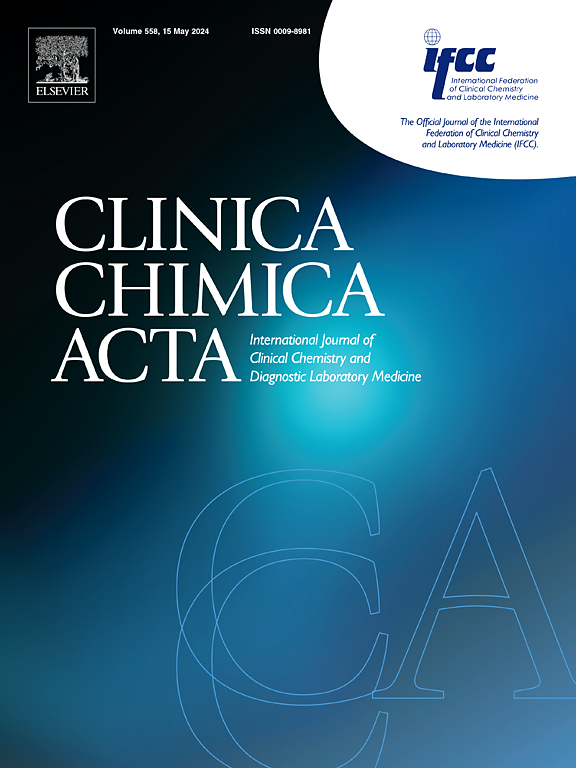胰腺炎生物标志物的免疫检测研究进展。
IF 2.9
3区 医学
Q2 MEDICAL LABORATORY TECHNOLOGY
引用次数: 0
摘要
胰腺炎是胃肠道疾病的主要原因。然而,早期和准确的生物标志物检测对于指导风险分层和治疗决策至关重要,受到传统检测方法的敏感性和通量限制。本文综述了免疫分析技术的进展,包括高灵敏度脂肪酶和淀粉酶elisa,化学发光和时间分辨荧光格式,无标记等离子体传感器,数字单分子平台,以及应用于胰腺炎生物标志物定量的多重头和微阵列系统。本研究综合了经典酶标记物的数据,如脂肪酶和淀粉酶,已建立的蛋白质,包括c反应蛋白和胰蛋白酶原激活肽,以及新兴的分子靶标,如细胞因子,DAMPs和microRNAs。重点是评估分析性能指标,包括灵敏度、特异性、动态范围、精度和鲁棒性,以及分析前因素和临床应用。分析这些成分与早期诊断、严重程度评估和治疗反应评估的关系。当前在分析标准化、头对头验证和分析前变异性方面的挑战被强调,并探讨了微流体“芯片实验室”和护理点平台的潜力。这篇综述有效地将先进的免疫分析模式与胰腺炎特异性生物标志物的表现结合起来,从而独特地将技术创新与临床适用性联系起来。本研究旨在为个性化胰腺炎诊断中标准化多路检测的开发和实施提供优先路线图。本文章由计算机程序翻译,如有差异,请以英文原文为准。
Advances in Immunoassays for detection of pancreatitis biomarkers
Pancreatitis is a predominant cause of gastrointestinal morbidity. However, the early and accurate detection of biomarkers, which is essential for guiding risk stratification and therapeutic decision-making, is constrained by the sensitivity and throughput limitations of conventional assays. This review critically examines advances in immunoassay technologies, including high-sensitivity lipase and amylase ELISAs, chemiluminescence and time-resolved fluorescence formats, label-free plasmonic sensors, digital single-molecule platforms, and multiplex bead-based and microarray systems, as applied to pancreatitis biomarker quantitation. This study synthesizes data on classical enzymatic markers, such as lipase and amylase, established proteins, including C-reactive protein and trypsinogen activation peptide, and emerging molecular targets, such as cytokines, DAMPs, and microRNAs. The focus is on evaluating analytical performance metrics, including sensitivity, specificity, dynamic range, precision, and robustness, along with preanalytical factors and clinical applications. These components are analyzed in relation to early diagnosis, assessment of severity, and evaluation of therapeutic response. Current challenges in assay standardization, head-to-head validation, and preanalytical variability are highlighted, and the potential of microfluidic “lab-on-a-chip” and point-of-care platforms is explored. This review effectively integrates advanced immunoassay modalities with the performance of pancreatitis-specific biomarkers, thereby uniquely linking technological innovation to clinical applicability. This study aims to offer a prioritized roadmap for the development and implementation of standardized multiplexed assays in personalized pancreatitis diagnostics.
求助全文
通过发布文献求助,成功后即可免费获取论文全文。
去求助
来源期刊

Clinica Chimica Acta
医学-医学实验技术
CiteScore
10.10
自引率
2.00%
发文量
1268
审稿时长
23 days
期刊介绍:
The Official Journal of the International Federation of Clinical Chemistry and Laboratory Medicine (IFCC)
Clinica Chimica Acta is a high-quality journal which publishes original Research Communications in the field of clinical chemistry and laboratory medicine, defined as the diagnostic application of chemistry, biochemistry, immunochemistry, biochemical aspects of hematology, toxicology, and molecular biology to the study of human disease in body fluids and cells.
The objective of the journal is to publish novel information leading to a better understanding of biological mechanisms of human diseases, their prevention, diagnosis, and patient management. Reports of an applied clinical character are also welcome. Papers concerned with normal metabolic processes or with constituents of normal cells or body fluids, such as reports of experimental or clinical studies in animals, are only considered when they are clearly and directly relevant to human disease. Evaluation of commercial products have a low priority for publication, unless they are novel or represent a technological breakthrough. Studies dealing with effects of drugs and natural products and studies dealing with the redox status in various diseases are not within the journal''s scope. Development and evaluation of novel analytical methodologies where applicable to diagnostic clinical chemistry and laboratory medicine, including point-of-care testing, and topics on laboratory management and informatics will also be considered. Studies focused on emerging diagnostic technologies and (big) data analysis procedures including digitalization, mobile Health, and artificial Intelligence applied to Laboratory Medicine are also of interest.
 求助内容:
求助内容: 应助结果提醒方式:
应助结果提醒方式:


